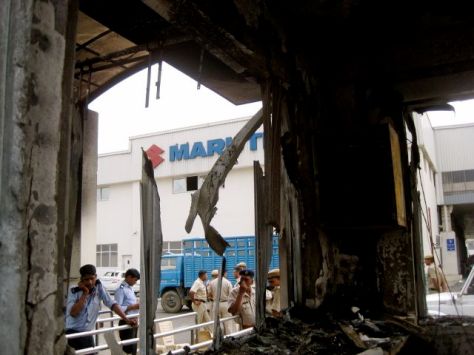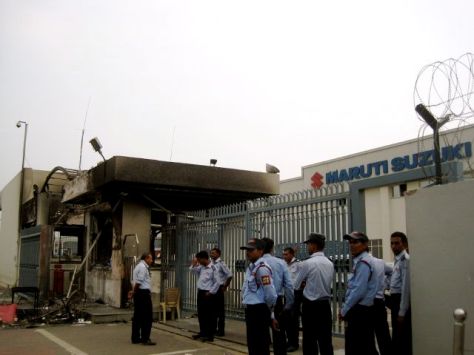Guest post by ANUMEHA YADAV

The year-long industrial conflict at Maruti Suzuki India Limited (MSIL), India’s largest automobile manufacturer’s Manesar plant turned violent on 18 July. At 3:30 pm on Wednesday afternoon, representatives from Maruti Suzuki Workers’ Union and the Maruti management had met to discuss the reinstatement of Jiya Lal, a permanent worker who had been suspended that morning after an altercation with his floor supervisor. Lal is a Dalit and alleges that he had reacted when the supervisor made derogatory casteist remarks against him. The workers were protesting that the management had been unfair, suspending Lal from service while merely sending the supervisor home on leave for a few days.The afternoon meeting did not reach any resolution. By 7:30 pm the workers’ discontent simmering since a few days back, turned violent. In the rioting that followed, forty managers including MSIL’s Japanese staff got injured. Human resources manager Awanish Kumar Dev died of burn injuries. “Armed with iron rods and door beams of cars, the mob spread out in groups in the factory area and targeted supervisors, managers and executives rendering many of their victims bleeding and unconscious,” Maruti said in a statement. Over 90 workers have been arrested from their homes in villages near Manesar. Many are on the run.
On Friday, there was stillness at the factory, except for an afternoon dust-storm. Police jeeps went in and out of the plant. From time to time, a TV news crews reported standing in front of the charred remains of the security post at Gate No. 2. The same gate has been the main site of several of the workers’ protests between June and October last year when over 4000 workers of them had demanded a union independent of the management’s influence and better work conditions.
While there is shock and outrage at the Wednesday incident, and there is despair too that what had been a powerful but non-violent agitation for workers’ constitutional rights took a ghastly violent turn. Workers’ groups such as the Bigul Mazdoor Dasta are demanding investigations as to what provoked this turn to violence by workers who had protested peacefully through strikes and dharnas for five months last year, including when they had occupied the plant 13 days in June and later when they protested sitting outside the plant for 33 days in September.
The FIR names 55 workers including the new union’s Chief Patron Sandeep Dhillon, Secretary Sarabjeet Singh, Pradhan Ram Meher, and other union functionaries. They have been charged under section 147, 148, 149, 452, 302, 307, 436, 323, 332, 353, 427, 114 of IPC which include charges of rioting armed with deadly weapons, murder, and attempt to murder. Maruti management accuses them of having planned this violence.
Since the incident all union functionaries have been unreachable. Speaking on the phone, some workers traced the sequence of events further back to Monday. Since March, MSIL management and the newly-formed Maruti Suzuki Workers Union (MSWU) have been negotiating a settlement on several issues including wage increase, reducing the duration of the training period from three to two years, improving transport facilities for workers. Workers say that on Monday, these negotiations reached a stalemate when the management announced that the wage increase will be a total of Rs 10,500 (Rs 6000 the first year, Rs 2500 and Rs 2000 the following years), not Rs 15000-Rs 18000 as workers were demanding and thought comparable to their peers in companies like Honda.
At MSIL, a permanent worker gets Rs17,000 a month, while a casual worker gets Rs7,000. Of this a part is fixed, and the rest is a variable component which gets deduced depending of number of leaves taken by the worker. Regularization of leave benefits was one of the issues the management and the union leaders were negotiating. Workers were demanding wage increases commensurate with inflation. Last year researchers Prasenjit Bose and Sourindra Ghosh had demonstrated a squeeze in MSIL workers’ real wages in an op-ed in The Hindu, calculating that between 2007 and 2011 while MSIL workers’ yearly earnings increased by 5.5 percent, the consumer price index (for the Faridabad centre, Haryana), went up by over 50 per cent. They calculated that MSIL profits after taxes have increased by 2200 percent since 2001.

Speaking to reporters after the Wednesday incident, MSIL management denied that the wage negotiations had reached finality. But workers say that they were protesting the management’s announcement on wage negotiations when they refused to attend “morning meetings” on Tuesday. These are 20-minute meetings held before each of the three work-shifts starting at 6:30 am, 3:30 pm, 11:30 pm in which workers assemble for that shift’s attendance, and do a few exercises for warming-up, and supervisors assign them to work-stations. They continued this on Wednesday. On Wednesday morning, Ram Kishore Maji a supervisor from assembly floor stopped Jiya Lal and a few other workers in the morning shift returning from their tea-break at 8:30 am instructing them to not discontinue the pre-shift meetings. This resulted in an argument which the workers say became an altercation when the supervisor hurled a casteist abuse at Lal.
Workers who were in Shift B reached the premises at 3 pm, the union leaders asked the morning Shift A workers to continue being inside the plant. “They asked us to do so to demonstrate that we have unity even for one worker”, says a worker. The union leaders went into the company office for a meeting with the management at 3:30 pm. “When we reached everything was peaceful. Our general body members said we are going for a meeting but let work continue. We found out that a meeting was on to take back a suspended worker, and should end by 5:30 pm. Till 6:30-7 pm we stayed on the floor and were making cars on the assembly-line,”says a 29-year old worker from the veldshop. Workers say that labour officials were also called to this meeting. The FIR names Labour Officer Dinesh and Labour Inspector Chandrapal as being present at the meeting.
“At 5 pm we heard the management had refused to take Lal back or to talk any further that day. Our body members requested to talk to Mr S Y Siddiqui who is one of the high officials because the Manesar officials were saying it is not in their hands but in the top officials’. Maybe our body members persisted because they were under pressure too. Some workers feel the union has achieved nothing since they were appointed as leaders in February. The management just postpones settling on any of our demands,” says a 24-year old worker from the paintshop. It is a significant departure from April, when most workers were optimistic about their new union and appreciative of the management agreeing to changes like placing an extra worker at each workstation to act as a reliever for workers. At the time, they had been keen to build on their union’s structures and negotiate with management even as 2,000 workers of Orient Craft, India’s largest apparel exporter, went on a violent protest at Honda Chowk a few kms away. Maruti Suzuki Workers’ Union had submitted its demand for a pay revision in April. But by June, the negotiations were beginning to run into difficulties. On 20 June, The Economic Times reported that the Haryana labour department had filed a challan in the Gurgaon court against Maruti executives for violating the agreement reached with the workers last October on forming grievance redressal and labour welfare committees to negotiate on some concerns.
Workers say that after 7 pm, the situation deteriorated quickly. They recount that at this time workers from Shift A were asked by union leaders to come outside the factory. Workers from Shift B then joined them. They describe around 100 policemen being present outside the factory since late afternoon when the meeting began but that both the police and the guards, outnumbered by thousands of protesting workers, were unable to intervene.
Workers give differing versions of what provoked the violence and if it started during the meeting itself, a detail for which the CCTV footage from the company office may prove crucial. Haryana government has formed a SIT under Assistant Commissioner of Police Gurgaon Ravinder Tomar to investigate the matter.
(Anumeha Yadav is an independent journalist based in Delhi.)

Thanks Anumeha for filing this report especially now given how the event has been sensationalised by a majority of media outlets and not being considered in its historic context. Also, it’s unfortunate that somebody ended up losing his life.
LikeLike
its a mug’s game really. the corporates and the state wear you down if you practice non-violence by just stonewalling all demands. The state in Japan would not allow Suzuki to do what the state in India has. with frustrations mounting it is quire possible that agents provocatuers were used by the management. at least that is what a statement from the union is saying.
LikeLike
thanks for the report. all reported facts in newspapers seen bungled beyond any sense of calrity.
LikeLike
Cost of one casteist remark.
LikeLike
In such circumstances (violence), it is the workers who always lose and it really hits them hard. I have been in industry (that too in a place like WB for more than eight years in the beginning of my career) and have seen all types of strikes both violent and non violent.
Whatever could be the reason for violence, it always leads to closures/lockouts and in such cases the workmen and their families are the worst affected.
I know of many instances in Kerala, WB and Karnataka where profit making units have totally shut-down for ever.
One can blame the management/Workers unions but once there is violence the workers lose the power to negotiate.
Hope this does not happen in this case.
LikeLike
I like Amaresh Mishra’s piece too. It’s pasted below.
http://blogs.timesofindia.indiatimes.com/the-mainstream-maverick/entry/manesar-class-struggle-of-the-21st-century
LikeLike
Thanks for sharing the news in details, had gone thorough many news article but this one was the best in deep. well drafted with the reports.
LikeLike
Good Anumeha. The central issue is that worker’s exploitation is increasing by the day. All kinds of devious ways are used to increase the industry’s profit. The fact is that the workers’ real wages have been falling. It is for the Indian state to protect the workers’ interests, but that state itself is desperately trying to ‘reform’ the labour laws so as to make its own working class more vulnerable to exploitation by foreign capital.
Keep it up
LikeLike
What is the current scenario has things changed up …did the workers got absorbed in other organizations …..wht has been governments role over the issue …did the hr’s family who was slaughtered got compensated for the same…what exactly has been the after effects of the incident
LikeLike